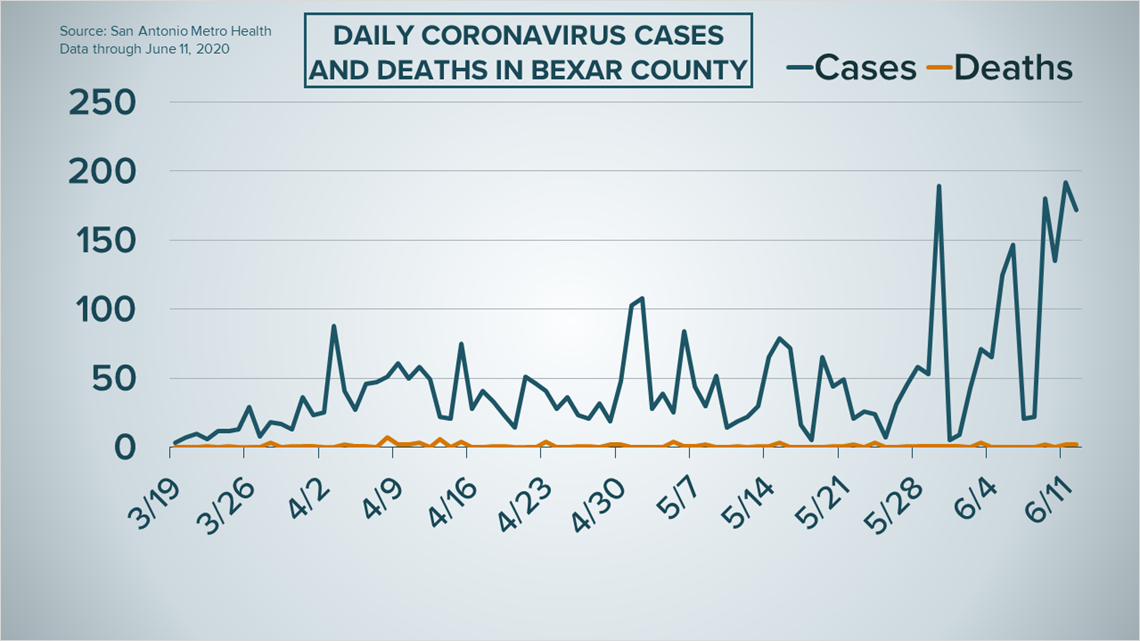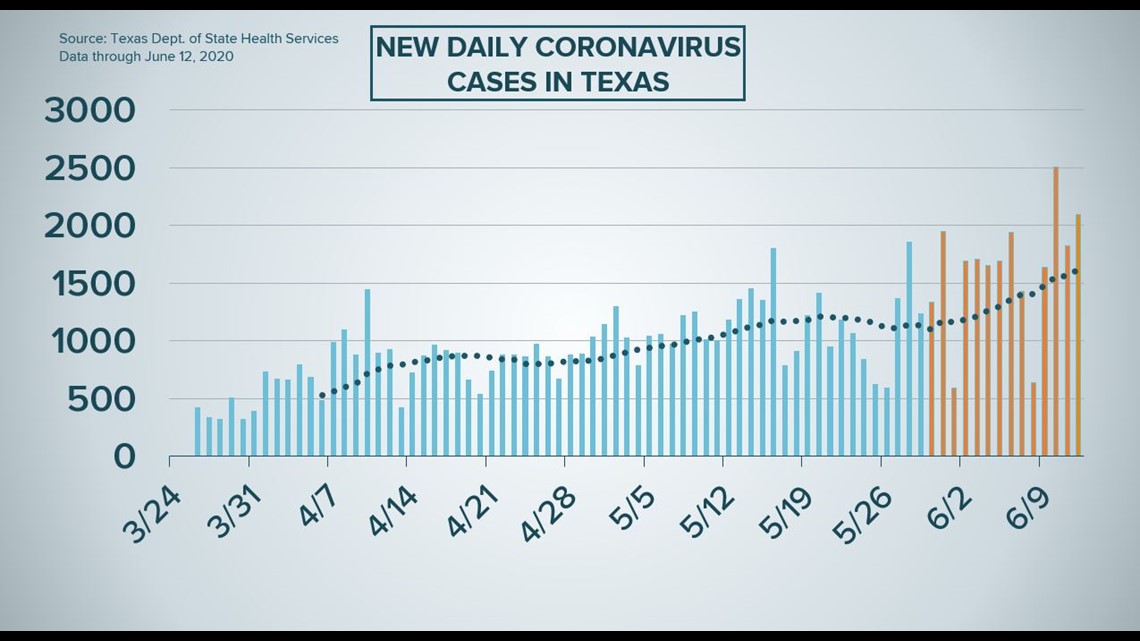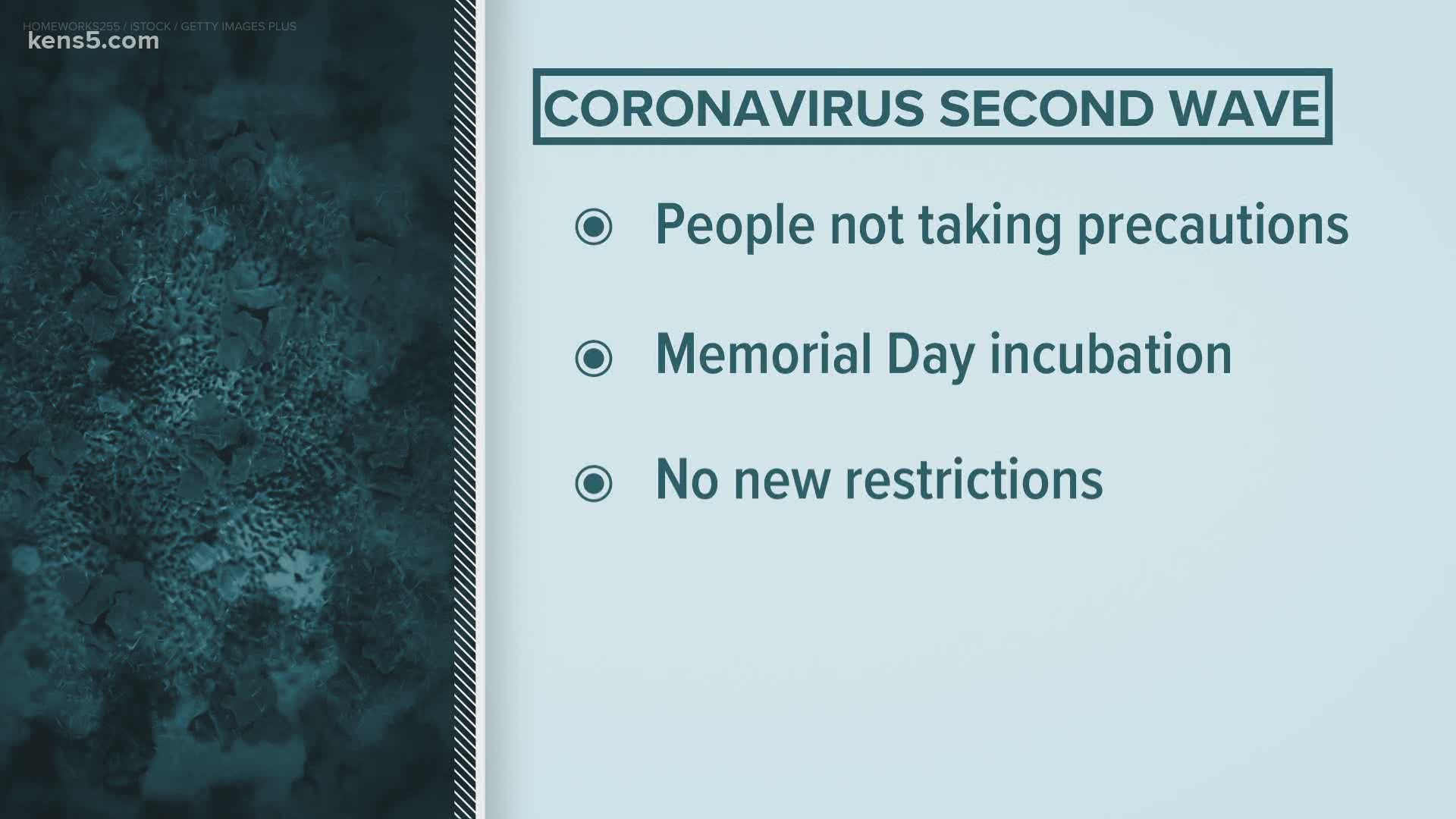SAN ANTONIO — We're tracking the latest numbers from the coronavirus pandemic in San Antonio and across Texas. Here are the latest numbers reported by Bexar and surrounding counties:
- Bexar County: 172 new cases Friday; a total of 4,012 cases and 84 fatalities
- Comal County: 10 new cases Friday; a total of 151 cases and seven fatalities. The county also confirmed six more recoveries from COVID-19, for a total of 121.
- Hays County: 99 new cases Friday; a total of 673 cases and five fatalities in the county.
By The Numbers:
Metro Health Director Dawn Emerick warned Thursday that the county was "entering a second wave," as daily coronavirus numbers continue to rise in the San Antonio area.
Bexar County Judge Nelson Wolff said Friday afternoon in a letter to Gov. Greg Abbott that Bexar County saw an additional 172 new cases Friday, part of a trend of larger case counts that started after Memorial Day. Nearly 30 percent of all COVID-19 cases in Bexar County have been recorded since June 1.
Wolff urged Abbott to allow local officials to mandate wearing masks. Abbott, however, has maintained that it would violate people's civil liberties to enforce such an ordinance.
Two new deaths were reported Friday, bringing the county's death toll to 84. Mayor Nirenberg did note Thursday that hospitalization numbers had increased in Bexar County; 122 patients are in local hospitals, while 54 patients in intensive care and 25 patients are on ventilators. The mayor did say that 79% of the county's ventilators remain available, while 31% of staffed hospital beds are available.
How Bexar County is trending:
We're tracking how many coronavirus cases are confirmed in Bexar County each day from the time San Antonio Metro Health began reporting cases more than two months ago. Graphing those daily case numbers along a 14-day moving average provides an accurate picture of the curve in the San Antonio area and the direction we're heading amid the coronavirus.




Coronavirus in Texas
The Texas Department of Health and Human Services reported an additional 2,097 coronavirus cases and 19 fatalities in the state Friday.
As of 4 p.m. Friday, Texas health officials have reported 83,680 total cases and 1,939 fatalities. The state estimates that 55,258 residents have recovered, while 26,483 residents are still ill with the virus.
Here's a look at the 14-day moving average of the new daily coronavirus cases in Texas.


It's important to note that hospitalizations have increased in the month of June. Between June 8-10, Texas set consecutive record highs for the number of COVID-19 patients in hospitals. On Monday, June 8, 1,935 residents were hospitalized with coronavirus; by Wednesday, June 10, that number had risen to 2,153.
In total, hospitalizations have increased by about 42% in the state since Memorial Day.
The state's COVID-19 positivity rate is 6.92% as of Wednesday; before Memorial Day, that number was 4.27%.
Coronavirus symptoms
The symptoms of coronavirus can be similar to the flu or a bad cold. Symptoms include fever or chills, cough, shortness of breath or difficulty breathing, fatigue, muscle or body aches, headache, new loss of taste or smell sore throat, congestion or runny nose, nausea or vomiting and diarrhea, according to the Centers for Disease Control.
Most healthy people will have mild symptoms. A study of more than 72,000 patients by the Centers for Disease Control in China showed 80 percent of the cases there were mild.
But infections can cause pneumonia, severe acute respiratory syndrome, kidney failure, and even death, according to the World Health Organization. Older people with underlying health conditions are most at risk.
The CDC believes symptoms may appear anywhere from two to 14 days after being exposed.
Human coronaviruses are usually spread...
- Between people who are in close contact with one another (within about 6 feet).
- Through respiratory droplets produced when an infected person coughs, sneezes or talks. These droplets can land in the mouths or noses of people who are nearby or possibly be inhaled into the lungs.
- Some recent studies have suggested that COVID-19 may be spread by people who are not showing symptoms.
Help stop the spread of coronavirus
- Stay home when you are sick.
- Eat and sleep separately from your family members
- Use different utensils and dishes
- Cover your cough or sneeze with your arm, not your hand.
- If you use a tissue, throw it in the trash.
Lower your risk
- Wash your hands often with soap and water for at least 20 seconds. If soap and water are not available, use an alcohol-based hand sanitizer.
- Avoid touching your eyes, nose, and mouth with unwashed hands.
- Avoid close contact with people who are sick.
- Clean and disinfect frequently touched objects and surfaces.
- The CDC recommends wearing a mask or cloth face covering if you have to be out due to an essential service or essential activity such as going to the grocery store.
- If you are 60 or over and have an underlying health condition such as cardiovascular disease, diabetes or respiratory illnesses like asthma or COPD, the World Health Organization advises you to try to avoid crowds or places where you might interact with people who are sick.

